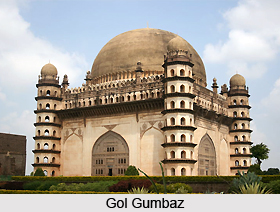 The monuments of Bijapur show a strong religious inclination in terms of the number of tombs and mosques found here. The most famous monument in Bijapur is the Gol Gumbaz, Mausoleum of Muhammad Adil Shah II (1627-57). It is the largest and most conspicuous building in Bijapur and one of the most celebrated in India. The Gumbaz was built during the peak of architectural prowess of the Adil Shahi dynasty of Bijapur.
The monuments of Bijapur show a strong religious inclination in terms of the number of tombs and mosques found here. The most famous monument in Bijapur is the Gol Gumbaz, Mausoleum of Muhammad Adil Shah II (1627-57). It is the largest and most conspicuous building in Bijapur and one of the most celebrated in India. The Gumbaz was built during the peak of architectural prowess of the Adil Shahi dynasty of Bijapur.
Gol Gumbaz was constructed in 1659 by a masterbuilder, Yaqut Dabuli. It resembles a giant cube, crowned by a hemispherical dome. The dome is the second largest in the world, with a diameter of almost 600 feet, next only to St. Peter`s in Rome.
One of the most outstanding aspects of its construction is the use of groined compartments or pendentives, which counteract the outer thrust of the dome. There are three inscriptions over the south doorway which gives the date of Muhammad Adil Shah`s death as 1657. His tomb lies right below the tomb at the centre of the chamber. Also contained in the Gumbaz are the graves of his wives, son and mistress. It is now a museum.
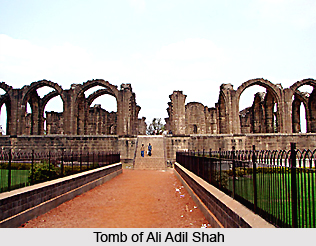 The Tomb of Ali Adil Shah I, built in 1580, is a plain edifice, rectangular in plan, surrounded by a corridor and containing four tombs. At the south-eastern corner is a high platform with a beautiful dark-green tombstone in the centre. It is not exactly known who lies in this grave, but clearly it is a person of rank.
The Tomb of Ali Adil Shah I, built in 1580, is a plain edifice, rectangular in plan, surrounded by a corridor and containing four tombs. At the south-eastern corner is a high platform with a beautiful dark-green tombstone in the centre. It is not exactly known who lies in this grave, but clearly it is a person of rank.
To the North of the citadel, is the unfinished Tomb of Ali Adil Shah II .It was built in 1650 with the intention to surpass every other monument in the city. A large dome over the central enclosure was meant to be the centrepiece. Moreover, the base measures 215 feet, compared to the 158 feet on the gumbaz. However, only the outer arcade of curious-looking Gothic arches remains. The masonry has been left undressed; ready for plastering. The tomb of Adil Shah is contained in a raised platform in the inner enclosure. To the southwest corner, a small platform for a female, reputed to be the tomb of Khursheed Khanam, mother of Sikander Rauza, the last of the Bijapur Sultans. Apart from these, there are a total of thirteen other graves found here.
Lying to the west of the city, 365 m from the Mecca gate, is the Ibrahim Rauza a splendid group of buildings which includes the tombs of Ibrahim Adil Shah II and his Queen, Taj Sultana. It was designed by Malik Sandal in 1626 and is enclosed by a high wall pierced by a tall gateway with corner minarets. Within it are two large buildings facing each other and set on a raised plinth.
The entire structure is over a basement. The mosque and tomb are contained within a square compound, based on a common raised terrace with a tank and fountain between them. The mosque has a facade of five arches and contains a rectangular shaped prayer chamber. This is kept in shade by a chhaja and at each corner is a slender minaret. A huge dome with a row of petal shaped protrusions at its base is contained within a square fenestration.
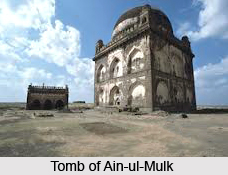 The tomb is square in shape and almost similarly constructed. It has double aisles around it, the inner one pillared. There are two narrow arches that break up the facade. On the inside, there are three arches on each wall each one panelled, decorated and embellishment with arabesque, floral and inscriptional traceries. The Chamber with the tomb has a curved and low ceiling and is separated by an empty space from the dome.
The tomb is square in shape and almost similarly constructed. It has double aisles around it, the inner one pillared. There are two narrow arches that break up the facade. On the inside, there are three arches on each wall each one panelled, decorated and embellishment with arabesque, floral and inscriptional traceries. The Chamber with the tomb has a curved and low ceiling and is separated by an empty space from the dome.
A number of secret passages are also said to exist within the structure with the possibility of hidden treasure. It has often been said that the garden tomb of Ibrahim Adil Shah II was the inspiration behind the beautiful Taj Mahal built by Shah Jahan.
There are two domed tombs close to the Mecca Gate known as the Jor Gumbaz or Two Sisters. The octagonal one is the Tomb of Khan Muhammad and of his son, Khawas Khan, Wazir to Sikander. Khan Muhammad was assassinated for his treachery in the field. The tomb has a high dome which springs from a foliated band of ornament. Within is a fine chamber. The plain square tomb is the Mausoleum of Abdul Razzak Qadir, the religious tutor of Khawas Khan and a man much revered. To the west is a third tomb, said to be that of Siddi Kalian, a minister under Muhammad.
The Tomb of Jehan Begum is similar in size and design to the Gol Gumbaz, with similar corner towers, but it is unfinished. It is uncertain precisely whose tomb this is; possibly the third wife of Muhammad Adil Shah II or his mother. Towards the Haidar Burj bastion, is the Sikander Rauza, a large plain tomb of the last of the Bijapur sultans (1672-86). Near the South East corner of the Jami Masjid lie the Tomb of Shah Karim Muhammad Qadri (1741) and that of Sayyid Abdul Rahman Qadri. Both boast ceilings alleged to be coated in pulverized mother of pearl, the latter with some pretty stucco work and iron bosses on the doors.
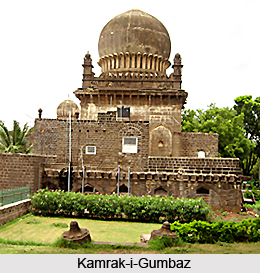 The Tomb of Ain-ul-Mulk is 2 miles to the east of the city. Built in 1565, it is a massive square building with an elegant dome and some pendant stuccowork. Adjacent is the mosque. The tomb and mosque of Yakut Dabuli is a beautiful one, enriched with lattice screens. He is known to have decorated the mihrab in the Jama Masjid in Bijapur. Over his tomb runs the inscription: `One atom of divine grace is better than to be chief of 1,000 villages."
The Tomb of Ain-ul-Mulk is 2 miles to the east of the city. Built in 1565, it is a massive square building with an elegant dome and some pendant stuccowork. Adjacent is the mosque. The tomb and mosque of Yakut Dabuli is a beautiful one, enriched with lattice screens. He is known to have decorated the mihrab in the Jama Masjid in Bijapur. Over his tomb runs the inscription: `One atom of divine grace is better than to be chief of 1,000 villages."
The tomb and mosque of Malik Sandal, the architect of Bijapur, can also be found here. It is a beautiful but modest edifice. Within the enclosed courtyard is a small canopy beneath which is a woman`s tomb, possibly that of his mother. One of the open-air tombs is that of the architect himself. In one corner is a primitive mosque. The other buildings contain arcades and tombs. Just to the north, the small canopied tomb with a ribbed dome is called the Kamrak-i-Gumbaz.
The cenotaph, mosque and palace of Afzul Khan can also be seen here. Afzul Khan died at the hands of the Maratha leader Chatrapati Shivaji at Partabgarh, where he was disembowelled by the latter with a baghnakh (tiger`s claw).He began the construction of his tomb and attendant mosque during his own lifetime. The mosque was completed in 1653 but the tomb remained unfinished. It is believed that he had a premonition of his own death before he went to meet Chatrapati Shivaji and is said to have personally put the date 1658 on his own cenotaph. It is said that he drowned his sixty-four wives in anticipation of his own demise. Beside the tomb is the mosque, a two-storey affair, the upper level reserved for the women of the zenana. To the south lie the ruins of his palace.
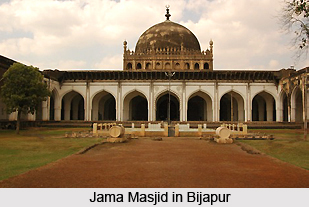 Some way south-west of this, in a grove of trees, is a platform with a large tank: the Muhammad Sarovar. On the platform are eleven rows of identical tombs, sixty-three in all, reputed to contain the remains of the drowned wives.
Some way south-west of this, in a grove of trees, is a platform with a large tank: the Muhammad Sarovar. On the platform are eleven rows of identical tombs, sixty-three in all, reputed to contain the remains of the drowned wives.
Also found here are the tombs of Chingdi Shah and Begum Sahiba, the wife of Aurangzeb.
A number of mosques are found in and around Bijapur, symbolic of the strong Islamic influence here.
The Jami Masjid lies to the south-west of the Gol Gumbaz, on the south side of the road leading from Alipur to the citadel. The construction of the mosque was started by Ali Adil Shah (1558-80) but was not completed until 1686. It is a finely proportioned building with arcaded sides and a large inner courtyard containing fountains and a reservoir. The mosque proper lies across the west end of the court, with a facade of nine bays crowned by a huge dome, probably the best proportioned in the city. The pavement is divided into rectangular compartments resembling prayer rugs, one for each worshipper. The subdivision was ordered by Aurangzeb. There are 2,250 spaces. The mihrab, gilded and inscribed with Persian verses, is from the time of Muhammad Adil Shah. It was designed by Yakut Dabuli.
Ali Shahid Pir`s mosque lies to the south of Mehtar mahal. There is a wagon-vaulted roof covering the entire structure. It has a finely-modelled facade enriched with receding lines of moulding around the arches, which lead to a deep-set appearance. Each end of the facade ends in a short, thin minaret Traces of the original encaustic tiles and enamel can be seen on the decorated mihrab, which, unusually, has a door inserted in it, providing access from outside. Above is a dome breaking the roof line. Adjoining the mosque is the tomb of Hazrat Sayyid Ali Shahid, after whom the mosque is named.
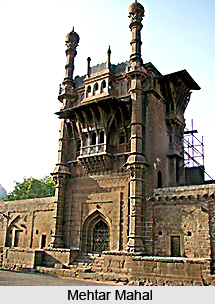 The Old Mosque lies to the north west of the gate, not very far from the Chini mahal. The Old Mosque has been constructed from an earlier Jain temple. The Mandapa has been used as a porch, and the inner doorway with perforated screens is Muslim. The main body of the mosque is built from a strange assortment of salvaged masonry, using Jain and Hindu pillars of various patterns and heights. There is an inscription in the upper part which states that Malik Karim-ud-Din built this section in 1320 and Revoy was the carpenter. Other inscriptions in the Sanskrit language and Kannada language survive even today.
The Old Mosque lies to the north west of the gate, not very far from the Chini mahal. The Old Mosque has been constructed from an earlier Jain temple. The Mandapa has been used as a porch, and the inner doorway with perforated screens is Muslim. The main body of the mosque is built from a strange assortment of salvaged masonry, using Jain and Hindu pillars of various patterns and heights. There is an inscription in the upper part which states that Malik Karim-ud-Din built this section in 1320 and Revoy was the carpenter. Other inscriptions in the Sanskrit language and Kannada language survive even today.
The Jhanjiri Mosque was built in 1600 by Ibrahim Adil Shah II in the honour of his daughter Malika Jehan. It is a compact, well-proportioned building with a rich facade. The central arch is cusped, the cornice and brackets finely chased, the outer edge of the former cut into scallops resembling lacework. Traceried windows, chhatris and perforated parapets enhance the delicacy of the composition.
Mecca Masjid (1669) is a lovely little mosque enclosed by high walls with crisply carved details. The massive minarets constructed from rough material are the only remnants of an earlier mosque on the site. The great walls are curious. Given the presence of the four large arched openings on the south face, it is evident that they were not intended for defence.
The Andu Masjid is located in the South West corner of the city on the East side of the road running south from the citadel to the Landa Kasab bastion. It was constructed in 1608 by Itbar Khan, one of the ministers of Ibrahim Adil Shah II. The entire structure is a two-storey building with a mosque situated on the second storey and a rest. There are three bays with four small minarets in the facade. The masonry is exceptionally fine and the whole affair is crowned by a ribbed melon-shaped dome, a pattern which is repeated on the domes to the minars. The dome and crest of the building are adorned with lace-like fringes.
The Chinch Diddi Mosque is situated on a bastion close to the east wall of the citadel. It overlooks the Asar Mahal. It is a plainly detailed building with some wall paintings within.
The Bukhara Masjid has some beautiful detailing work done. The brackets to the cornice and the internal stucco ornaments are notable. It was once occupied as the Post and Telegraph Office.
The Zamrud Masjid is a miniature mosque that is considered to be the smallest in the city at 12 feet. The mural carries Persian inscriptions from the holy Quran.
The Jami Masjid of Ibrahim I was built in 1551.It is an old-fashioned mosque with central piers and brick and mortar minarets over the corners.
The Chota Asar is a small mosque with rich stucco work which covers the walls, ceiling and facade.
The Atnin Dargahis located about 2 miles beyond the Shahapur Gate. It has a prominent white dome which forms a local landmark. On the way to the Dargah is an old sarai or inn, which was once the jail. The view from the hilltop across the surrounding countryside, which is dotted with mosques, tombs and ruins, is worthwhile. It contains a collection of old pictures.
Bijapur abounds in monuments each of which tells a tale about the great city as it existed during the reign of its ancient rulers. It was primarily a Muslim society, the effects of which are seen in the Indo-Islamic style of architecture adopted in the construction of the various monuments.




